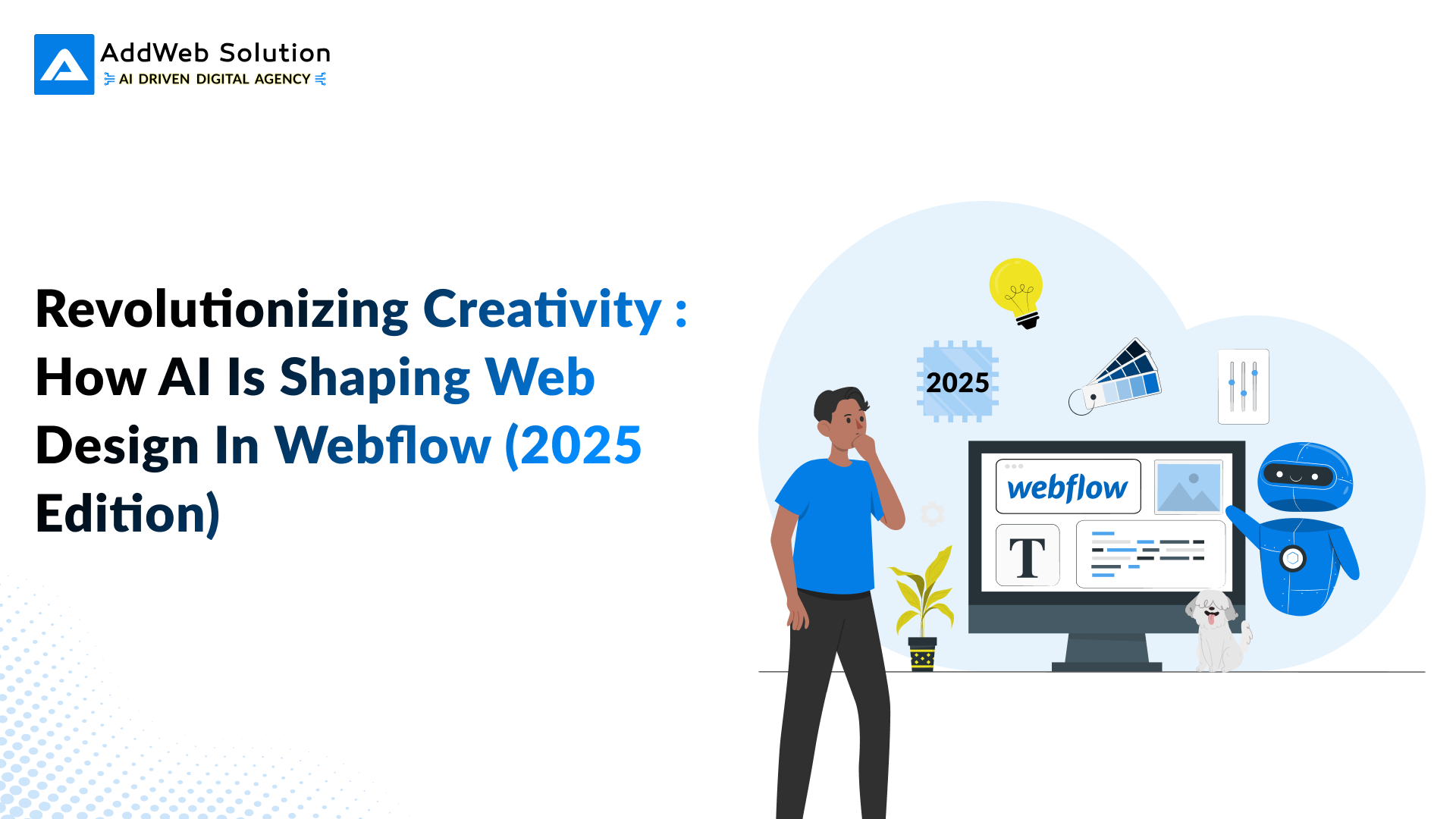By 2025, artificial intelligence (AI) has moved out of the classifications of a modest buzzword—it’s the dominant force propelling digital transformation, particularly in web design.
Startups and large-enterprise agencies alike are all experiencing the advantages of the leverage of AI, capitalizing on its power to streamline workflow, improve the user experience, and build superior, quicker sites. And spearheading this design revolution at its centre is Webflow—no-code, AI-carrying-the-heavy-lift like never before.
No matter if you are an individual designer, brand strategist, or one of a building web team, AI in Webflow is changing how you design, build, and develop sites. From automated SEO audits to AI-driven design workflows, we’ll look at how AI is changing web design in Webflow—and why 2025 could be the year AI-powered web design gets the most exciting ever.
1. AI-Assisted Design Workflows
Creating stunning, effective websites takes time, no longer. Webflow AI features in 2025 streamline time-consuming design work and convert hours of effort into minutes of automation.
AI-generated layout is perhaps the most revolutionary development. Webflow Labs has produced experimental tools in which you write out your design description in simple text—i.e., “a modern homepage with a centered headline, three feature cards, and a contact button”—and AI produces a fully responsive layout from it.
The tools also help with:
- Typographic matching based on brand tone and contrast principles
- Styling components based on your brand’s design system
- Color palette creation from mood boards or reference websites
By leveraging AI web design tools, creators can spend less time on mechanics and more time crafting meaningful experiences. This is Webflow design automation at its best—intelligent, flexible, and incredibly fast.
2. AI Content Generation
In modern web design, content is king. But writing compelling text, generating metadata, and translating content for multilingual sites is time-consuming. Enter AI content generation in Webflow.
AI content generators such as ChatGPT and Jasper are now part of Webflow’s CMS and design environment. This enables creators to generate:
- Hero headings and subheading
- Great CTAs (Call-to-Actions)
- Blog structure and complete drafts
- Localized content for international readers
This feature is especially beneficial for:
Early-stage ideation: AI can give suggestions when looking at a blank screen.
Dynamic CMS content: Automatically generate fields such as meta descriptions, alt tags, and summaries.
Multilingual websites: Automatically translate and convert content to cater to larger audiences.
AI is revolutionizing web design by allowing content creation as effortless as layout design. With AI and no-code building together, Webflow customers are able to build fully functional, content-filled sites without toggling between tools.

3. Personalized User Experiences
Web design in 2025 is no longer generic. Users today want customized experiences, and AI-driven personalization is serving them just that.
By combining AI tools with Webflow through applications like Zapier, Make (formerly Integromat), or custom JavaScript, designers can render dynamically:
- User-location-specific content
- Layouts that are optimized for user behaviour
- Product recommendations based on previous interactions
These intelligent experiences are powered by behaviour-based, real-time analysis of data, so sites can adapt as users interact with them. From showing New York visitors local event information to recommending tailored blog posts, AI UX Webflow solutions make your site human, contextual, and intuitive.
4. SEO & Accessibility Automation
SEO and accessibility are key to all websites’ success, but keeping them up to date can be so dull. Fortunately, AI for Webflow SEO is rendering the process obsolete.
AI plugins and native tools now do:
SEO audits: Inspect and create optimized title tags, meta descriptions, and structured data
Alt text suggestions: Create automatic descriptive and keyword-based image alt text
Accessibility reviews: Perform contrast ratio tests, ARIA label tests, keyboard navigation, and more
Core Web Vitals: Detect problems that impact performance, speed, and mobile usability
These tools work behind the scenes to ensure your site meets modern SEO and accessibility standards. Webflow automation tools make it easy to integrate these features without overwhelming designers, helping websites not only look good—but perform exceptionally across all devices and search engines.
5. AI-Powered Chatbots & Support Widgets
Customer support is also part of user experience, and AI web design now incorporates intelligent assistance integrated into Webflow websites.
- Using integration with tools such as:
- ChatGPT-powered assistants
- Intercom AI chatbots
- Drift or Radio Bots with NLP (Natural Language Processing)
Webflow websites can now deal with customer interactions. These bots deal with FAQs, capture lead data, guide users around the site, and even offer personalized product or service recommendations.
The icing on the cake? No back-end dev team needed. Solo creators can now provide enterprise-level support experiences with Webflow’s embed features and third-party plugins.

Build Smarter, Faster, and Better Today

Pooja Upadhyay
Director Of People Operations & Client Relations
6. Faster Prototyping with AI
One of the most thrilling web design trends with AI 2025 is how fast concepts are being ripped from paper to screen. Uizard, Figma AI extensions, and Galileo AI all convert wireframes and design elements into crude prompts or sketches by hand.
Designers can then export these wireframes into Webflow or use them as blueprints to quickly fill out:
- Landing pages
- Ecommerce designs
- Portfolio pages
- Blog templates
This velocity enables rapid iteration and client collaboration—cutting design cycles down to days, not weeks. AI prototyping enables you to experiment with numerous iterations, gather feedback, and launch your site with less pushback.
7. Predictive UX Improvements
What if your website could show what’s wrong—before the user disappears. That’s what predictive UX analysis is making possible on Webflow websites.
AI analytics capabilities allow designers to:
- Detect drop-off points in user flows
- Detect poorly performing CTAs or sections
- Enforce layout changes to boost engagement
- Enforce content placement based on scroll behaviour
AI not only informs you of what’s broken, but how and why it’s broken. With Webflow’s visual workflow built in, these tools now allow you to iterate more intelligently, not tediously.
With AI-powered tools such as Hotjar AI, Microsoft Clarity AI, or machine learning models you code yourself, you can send data into Webflow projects to optimize in real time. That’s how web design is getting smarter with AI—allowing live and actionable user feedback.
The Future: AI + Webflow = Creative Freedom
With the coming of AI into Webflow, it’s not the end of creative humanity. On the contrary, AI is poised to become the sidekick of the designer—to attend to the grunge while creators focus on the big picture.
With Webflow’s no-code innovation and visual development underpinned by smart AI capabilities, the sky is no longer the limit. Designers now get:
- More creative liberties
- Speedier time-to-market
- Faster-performing, more tailored websites
- Smooth scalability
In 2025, AI on Webflow is not about replacing creativity but augmenting it. It’s intelligent workflows, richer insights, and greater diversity of design.
As AI evolves, we’re going to see even smoother integration with tools across content, UX, SEO, and support. For designers, the future is not merely functional and quick—but genuinely inspired.
Final Thoughts
The AI web design age is now finally here, and Webflow is leading the charge with its ever-expanding array of automation, intelligence, and accessibility features. From crafting to deploying, AI is transforming how we engage with the design process—more dynamic, interactive, and human-centric than ever before.
If you haven’t found Webflow AI features yet, now it’s the time to. The future technologies already exist—and they’re changing the game for web development.

Boost Creativity With AI Tools

Pooja Upadhyay
Director Of People Operations & Client Relations

